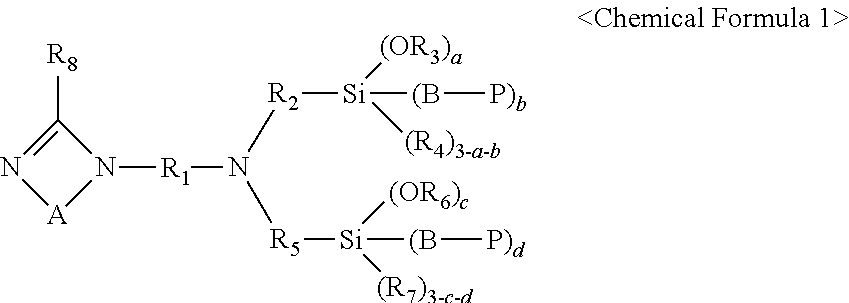End-functional conjugated diene-based polymer and method of preparing same
- Summary
- Abstract
- Description
- Claims
- Application Information
AI Technical Summary
Benefits of technology
Problems solved by technology
Method used
Image
Examples
example 1
[0096]270 g of styrene, 710 g of 1,3-butadiene, 5000 g of n-hexane, and 1.08 g of 2,2-bis(2-oxolanyl)propane as a polar additive were placed in a 20 L autoclave reactor, and then the temperature inside the reactor was raised to 40° C. When the temperature inside the reactor reached 40° C., 4 mmol of n-butyllithium was placed in the reactor, followed by an adiabatic heating reaction.
[0097]After about 25 min, 1.19 mmol of hexamethylcyclotrisiloxane was added, and an end-capping reaction was carried out for 15 min.
[0098]Thereafter, 2.73 mmol of N,N-bis(triethoxysilylpropyl)aminopropyl-1-imidazole was added, and the reaction was carried out for 15 min. Then, the polymerization reaction was stopped using ethanol, and 45 mL of a solution of 0.3 wt % BHT (butylated hydroxytoluene) antioxidant in hexane was added. The resulting polymer was placed in water warmed with steam and stirred to remove the solvent, followed by roll drying to remove the remaining solvent and water, yielding a modifi...
example 2
[0099]A polymer was prepared in the same manner as in Example 1, with the exception that the end-capping reaction was carried out using 2.73 mmol of hexamethylcyclotrisiloxane.
preparation examples
[0106]The conjugated diene-based polymer rubber compositions were prepared using, as raw rubber, samples A and B shown in Table 1, under the mixing conditions of Table 2 below. The unit of material in Table 2 is phr, based on 100 parts by weight of rubber.
[0107]Specifically, the conjugated diene-based polymer rubber composition was kneaded through primary kneading and secondary kneading. Upon primary kneading, raw rubber (conjugated diene-based polymer), a filler, an organosilane coupling agent, oil, zinc oxide, a stearic acid antioxidant, an anti-aging agent, wax and an accelerator were kneaded using a Banbury mixer provided with a temperature controller. For this, the temperature of the kneader was controlled, and a first mixture was obtained at a discharge temperature of 145 to 155° C. Upon secondary kneading, the first mixture was cooled to room temperature, after which rubber, sulfur and a vulcanization accelerator were placed in the kneader, followed by mixing at 100° C. or le...
PUM
| Property | Measurement | Unit |
|---|---|---|
| Percent by mass | aaaaa | aaaaa |
| Percent by mass | aaaaa | aaaaa |
| Percent by mass | aaaaa | aaaaa |
Abstract
Description
Claims
Application Information
 Login to View More
Login to View More - R&D
- Intellectual Property
- Life Sciences
- Materials
- Tech Scout
- Unparalleled Data Quality
- Higher Quality Content
- 60% Fewer Hallucinations
Browse by: Latest US Patents, China's latest patents, Technical Efficacy Thesaurus, Application Domain, Technology Topic, Popular Technical Reports.
© 2025 PatSnap. All rights reserved.Legal|Privacy policy|Modern Slavery Act Transparency Statement|Sitemap|About US| Contact US: help@patsnap.com



